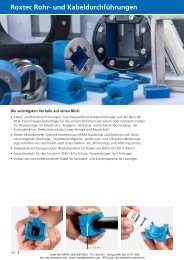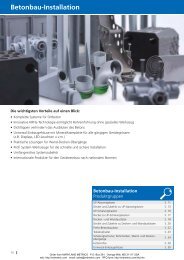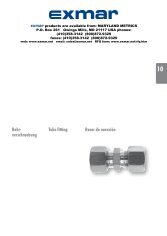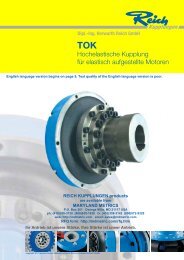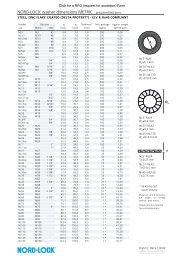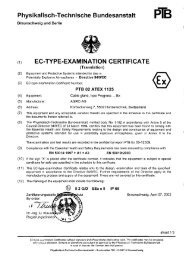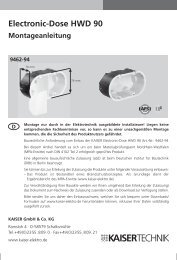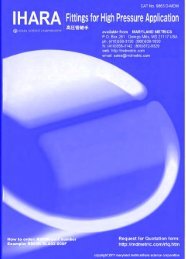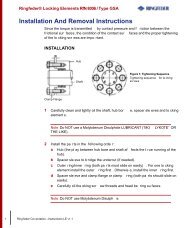- Page 1 and 2:
NB Products are available from MARY
- Page 3 and 4:
Eng- 112 Tech- 17 INDEX- 18
- Page 5 and 6:
SLIDE GUIDE SEBS-B/BY P.A-26 SEBS-B
- Page 7 and 8:
BALL SPLINE SSP/SSPS P.B-16 SSPM P.
- Page 9 and 10:
SLIDE BUSH GM P.D- 12 GW P.D-120 SM
- Page 11 and 12:
SLIDE BUSH (Flange Type) SMFC P.D-
- Page 13 and 14:
SLIDE UNIT SWA P.E-38 SWJ P.E-40 SW
- Page 15 and 16:
SLIDE SHAFT SN P.G-6 SNS P.G-7 SNT
- Page 17 and 18:
INDEX AK Slide Unit : Compact Block
- Page 19 and 20:
SA Slide Unit : Shaft Support Rail
- Page 21 and 22:
SMS-G Slide Bush : Standard Type, A
- Page 23 and 24:
SW Slide Bush (Inch Standard) : Sta
- Page 25 and 26:
A-1 SLIDE GUIDE BALL SPLINE ROTARY
- Page 27 and 28:
Table A-1 Types miniature type high
- Page 29 and 30:
RIGIDITY AND PRE-LOAD The rolling e
- Page 31 and 32:
MOUNTING A-7 Slide guides have a h
- Page 33 and 34:
A-9 Mounting: In general, a slide
- Page 35 and 36:
When reference surface is not provi
- Page 37 and 38:
Figure A-23 Examples of Joined Guid
- Page 39 and 40:
Bellows Option (Series: GL or SGL)
- Page 41 and 42:
A-17 Calulcation method of length
- Page 43 and 44:
Simplified lubrication management A
- Page 45 and 46:
A-21 The SEB(S) type slide guides
- Page 47 and 48:
RATED LOAD The load rating for SEB(
- Page 49 and 50:
MOUNTING BOLTS Extremely small cust
- Page 51 and 52:
H b MR 0 -0.1 B P1 W 0 -0.05 C 4-S
- Page 53 and 54:
H b W MR 0 -0.1 Refer to page A-2
- Page 55 and 56:
H 1 H1 mm 2 2.6 4 4.7 5.5 7.5 9.5 1
- Page 57 and 58:
H 1 A-33 L2(with side-seal) L1(with
- Page 59 and 60:
TYPES SER-type slide guides are ava
- Page 61 and 62:
Figure A-48 Shoulder Shape-2 r1 r1
- Page 63 and 64:
Refer to page A-35 for a descriptio
- Page 65 and 66:
Refer to page A-35 for a descriptio
- Page 67 and 68:
BLOCK TYPES A-43 Six different typ
- Page 69 and 70:
Clean Operation A-45 Ball cushions
- Page 71 and 72:
MOUNTING A-47 As shown in Figure A
- Page 73 and 74:
H 1 T1 mm 5 6 6.5 9 8.5 1,240 1,36
- Page 75 and 76:
H 1 1 Refer to page A-43 for a desc
- Page 77 and 78:
H 1 T1 mm 9 8 13.5 12 15.5 20 1,24
- Page 79 and 80:
T1 mm 5 6 6.5 9 H 1 8.5 1,240 1,360
- Page 81 and 82:
T1 mm 5 6 6.5 9 8.5 H 1 1,240 1,360
- Page 83 and 84:
H 1 T1 mm 5 8 9.5 9 8.5 10 T greas
- Page 85 and 86:
BLOCK TYPES A-61 Six different typ
- Page 87 and 88:
MOUNTING Slide guides are generally
- Page 89 and 90:
H 1 1 Refer to page A-61 for a desc
- Page 91 and 92:
H 1 H1 mm 13.5 16 20 24 27.5 1,120
- Page 93 and 94:
H 1 H1 mm 13.5 16 20 24 27.5 36.5
- Page 95 and 96:
H 1 H1 mm 13.5 16 20 24 27.5 1,120
- Page 97 and 98:
H 1 H1 mm 13.5 16 20 24 27.5 1,120
- Page 99 and 100:
H 1 H1 mm 13.5 16 20 24 27.5 36.5
- Page 101 and 102:
ACCURACY A-77 Three accuracy grade
- Page 103 and 104:
GREASE FITTING A-79 A grease fitti
- Page 105 and 106:
6-S, D drill Refer to page A-77 fo
- Page 107 and 108:
The NB ball spline consists of a sp
- Page 109 and 110:
Table B-2 Types of Spline Nut type
- Page 111 and 112:
ACCURACY The NB ball spline is meas
- Page 113 and 114:
LIFE CALCULATION Because ball eleme
- Page 115 and 116:
Fit: A transition fit between an SS
- Page 117 and 118:
Mounting of SSPM Type Spline: Examp
- Page 119 and 120:
Mounting of SSPF Type Spline: Examp
- Page 121 and 122:
SSP TYPE Cylindrical Spline Nut p
- Page 123 and 124:
SSPM TYPE Keyless Spline Nut part
- Page 125 and 126:
SSPF TYPE Flange Type Nut part nu
- Page 127 and 128:
SSPT TYPE Two Side Cut Flange Type
- Page 129 and 130:
SPA TYPE Keyless Block Type part
- Page 131 and 132:
SPA-W TYPE Keyless Block Double Ty
- Page 133 and 134:
SSPB TYPE Block Type part number
- Page 135 and 136:
STANDARD BALL SPLINE part number st
- Page 137 and 138:
The NB rotary ball spline can be us
- Page 139 and 140:
PRE-LOAD AND CLEARANCE IN ROTATIONA
- Page 141 and 142:
OPERATING ENVIRONMENT Certain opera
- Page 143 and 144:
SPR TYPE part number structure exam
- Page 145 and 146:
The NB stroke ball spine SPLFS type
- Page 147 and 148:
PRE-LOAD AND CLEARANCE IN ROTATIONA
- Page 149 and 150:
SPLFS TYPE - Two Side Cut Flange Ty
- Page 151 and 152:
C-1 SLIDE GUIDE BALL SPLINE ROTARY
- Page 153 and 154:
TOPBALL TOPBALL unit closed type op
- Page 155 and 156:
Load coefficient (fw): When calcula
- Page 157 and 158:
Shaft and Housing: To optimize NB T
- Page 159 and 160:
mm 22.0 22.9 24.9 31.5 44.1 52.1 60
- Page 161 and 162:
120 inch .515 .703 1.032 1.112 1.2
- Page 163 and 164:
TKA-W TYPE Double-Wide Block Type
- Page 165 and 166:
TKE-W TYPE Double-Wide Open Block
- Page 167 and 168:
TKD-W TYPE Clearance Adjustable Do
- Page 169 and 170:
TWA-W TYPE Double-Wide Block Type
- Page 171 and 172:
TWJ-W TYPE Clearance Adjustable Do
- Page 173 and 174:
TWD-W TYPE Double-Wide Open Block
- Page 175 and 176:
The NB slide bush is a linear motio
- Page 177 and 178:
Table D-2 Types (2) standard type c
- Page 179 and 180:
SPECIFICATIONS Dimensional Series:
- Page 181 and 182:
Examples of Mounting methods are sh
- Page 183 and 184:
Notes on Installation: When inserti
- Page 185 and 186:
GM TYPE Single Type part number s
- Page 187 and 188:
GMF-W TYPE Round Flange Double-Wid
- Page 189 and 190:
GMK-W TYPE Square Flange Double-Wi
- Page 191 and 192:
GMT-W TYPE Two Side Cut Double-Wid
- Page 193 and 194:
GMF-W-E TYPE Round Flange Double-W
- Page 195 and 196:
GMK-W-E TYPE Square Flange Double-
- Page 197 and 198:
GMT-W-E TYPE Two Side Cut Double-W
- Page 199 and 200:
SM TYPE Standard Type This type i
- Page 201 and 202:
SM-AJ TYPE Clearance-Adjustable Ty
- Page 203 and 204:
SM-OP TYPE Open Type This type is
- Page 205 and 206:
SM-W TYPE Double-Wide Type This t
- Page 207 and 208:
SMF TYPE Round Flange Type This t
- Page 209 and 210:
SMK TYPE Square Flange Type This
- Page 211 and 212:
SMT TYPE Two Side Cut Flange Type
- Page 213 and 214:
SMF-E TYPE Round Flange Type with
- Page 215 and 216:
SMK-E TYPE Square Flange Type with
- Page 217 and 218:
SMT-E TYPE Two Side Cut Pilot End
- Page 219 and 220:
SMF-W TYPE Round Flange Double-Wid
- Page 221 and 222:
SMK-W TYPE Square Flange Double-Wi
- Page 223 and 224:
SMT-W TYPE Two Side Cut Double-Wid
- Page 225 and 226:
SMFC TYPE Center Mount Round Flang
- Page 227 and 228:
SMKC TYPE Center Mount Square Flan
- Page 229 and 230:
SMTC TYPE Two Side Cut Center Flan
- Page 231 and 232:
SMF-W-E TYPE Round Flange Double-W
- Page 233 and 234:
SMK-W-E TYPE Square Flange Double-
- Page 235 and 236:
SMT-W-E TYPE Two Side Cut Double-W
- Page 237 and 238:
TRF TYPE Triple-Wide Round Flange
- Page 239 and 240:
TRK TYPE Triple-Wide Square Flange
- Page 241 and 242:
TRFC TYPE Triple-Wide Intermediate
- Page 243 and 244:
TRKC TYPE Triple-Wide Intermediate
- Page 245 and 246:
TRF-E TYPE Triple-Wide Round Flang
- Page 247 and 248:
TRK-E TYPE Triple-Wide Square Flan
- Page 249 and 250:
KB TYPE Standard Type This type i
- Page 251 and 252:
KB-AJ TYPE Clearance Adjustable Ty
- Page 253 and 254:
KB-OP TYPE Open Type This type is
- Page 255 and 256:
KB-W TYPE Double-Wide Type This t
- Page 257 and 258:
KBF TYPE Round Flange Type This t
- Page 259 and 260:
KBK TYPE Square Flange Type This
- Page 261 and 262:
KBT TYPE Two Side Cut Flange Type
- Page 263 and 264:
KBF-W TYPE Round Flange Double-Wid
- Page 265 and 266:
KBK-W TYPE Square Flange Double-Wi
- Page 267 and 268:
KBFC TYPE Center Mount Round Flang
- Page 269 and 270:
KBKC TYPE Center Mount Square Flan
- Page 271 and 272:
SW TYPE Standard Type This type i
- Page 273 and 274:
SW-AJ TYPE Clearance Adjustable Ty
- Page 275 and 276:
SW-OP TYPE Open Type This type is
- Page 277 and 278:
SW-W TYPE Double-Wide Type This t
- Page 279 and 280:
SWF TYPE Round Flange Type This t
- Page 281 and 282:
SWK TYPE Square Flange Type This
- Page 283 and 284:
SWT TYPE Two Side Cut Flange Type
- Page 285 and 286:
SWF-W TYPE Round Flange Double-Wid
- Page 287 and 288:
SWK-W TYPE Square Flange Double-Wi
- Page 289 and 290:
SWFC TYPE Center Mount Round Flang
- Page 291 and 292:
SWKC TYPE Center Mount Square Flan
- Page 293 and 294:
GW TYPE Single Type part number s
- Page 295 and 296:
Table E-1 types A wide variety of
- Page 297 and 298:
Table E-3 metric series types shaht
- Page 299 and 300:
ACCURACY The accuracy of the SA typ
- Page 301 and 302:
SMA TYPE Block Type part number s
- Page 303 and 304:
SMA-W TYPE Double-Wide Block Type
- Page 305 and 306:
AK TYPE Compact Block Type part nu
- Page 307 and 308:
AK-W TYPE Double-Wide Compact Block
- Page 309 and 310:
SMB TYPE Block Type part number st
- Page 311 and 312:
SMP TYPE Pillow Block Type part n
- Page 313 and 314:
SMJ TYPE Clearance Adjustable Type
- Page 315 and 316:
SME TYPE Open Block Type part numb
- Page 317 and 318:
SME-W TYPE Double-wide Open Block T
- Page 319 and 320:
SMD TYPE Open Block with Clearance
- Page 321 and 322:
RB TYPE Resin Block Type part numb
- Page 323 and 324:
SH TYPE Shaft End Supporter (Cast
- Page 325 and 326:
E-32 part number structure example
- Page 327 and 328:
CE TYPE Non-Clearance Adjustable T
- Page 329 and 330:
CD TYPE Clearance Adjustable Type
- Page 331 and 332:
SWA TYPE Block Type (Inch Series)
- Page 333 and 334:
SWJ TYPE Clearance Adjustable Bloc
- Page 335 and 336:
SWD TYPE Open Block Type (Inch Se
- Page 337 and 338:
RBW TYPE Resin Block Type (Inch S
- Page 339 and 340:
WA TYPE Shaft Support Rail (Inch
- Page 341 and 342:
The NB stroke bush is a linear and
- Page 343 and 344:
F-4 SR TYPE SR 20 part number struc
- Page 345 and 346:
F-6 SR-B TYPE SR 20 part number str
- Page 347 and 348:
NB's Slide Rotary Series consists o
- Page 349 and 350:
Application Examples Application Ex
- Page 351 and 352:
SRE TYPE part number SRE
- Page 353 and 354:
SREK TYPE Square Flange type
- Page 355 and 356:
F-16 SLIDE ROTARY UNIT SMA-R TYPE B
- Page 357 and 358: F-18 SLIDE ROTARY UNIT AK-R TYPE Co
- Page 359 and 360: SLIDE ROTARY UNIT SMP-R TYPE Pillow
- Page 361 and 362: NB's RK type slide rotary bush is a
- Page 363 and 364: G-1 SLIDE GUIDE BALL SPLINE ROTARY
- Page 365 and 366: SN/SNS/SNT Type (NB Shaft) P.G-6,7,
- Page 367 and 368: The Geometrical moment of inertia (
- Page 369 and 370: SNS TYPE NB Stainless Steel Shaft
- Page 371 and 372: NB CENTER-LINED TAPPED SHAFT G-9 A
- Page 373 and 374: SNWS TYPE NB Inch Stainless Steel
- Page 375 and 376: SNWS-PD NB Inch Pre-Drilled Stainl
- Page 377 and 378: MACHINING EXAMPLE NB can fabricate
- Page 379 and 380: Shaft (spindle) Shaft (Quill) Pleas
- Page 381 and 382: Please send drawing for quotation o
- Page 383 and 384: NBs Slide Way NV and NVT types inco
- Page 385 and 386: Figure H-5, Parallelism m 10 8 6 4
- Page 387 and 388: MOUNTING NV TYPE Accuracy of mounti
- Page 389 and 390: NV TYPE part number structure examp
- Page 391 and 392: NVT TYPE part number structure exam
- Page 393 and 394: The NB slide way is a non-recircula
- Page 395 and 396: Example: Figure H-17 SV Type Slide
- Page 397 and 398: SPECIAL BOLT (BT type) BT type spec
- Page 399 and 400: SV TYPE SV1/SV2 part number struc
- Page 401 and 402: SV TYPE SV3/SV4 part number struc
- Page 403 and 404: SV TYPE SV6/SV9 part number struc
- Page 405 and 406: SV TYPE SV12 part number structur
- Page 407: SVW TYPE part number structure exam
- Page 411 and 412: The NB slide table is a precision t
- Page 413 and 414: RATED LIFE The life of an NB slide
- Page 415 and 416: H-34 SVT TYPE SVT1/SVT2 part numb
- Page 417 and 418: H-36 SVT TYPE SVT3/SVT4 part numb
- Page 419 and 420: H-38 SVT TYPE SVT6/SVT9 part numb
- Page 421 and 422: SYT TYPE SYT1/SYT2 part number st
- Page 423 and 424: SYT TYPE SYT3 part number structu
- Page 425 and 426: SYT-D TYPE SYT1/SYT2 part number
- Page 427 and 428: SYT-D TYPE SYT3 part number struc
- Page 429 and 430: The NB miniature slide table SYBS t
- Page 431 and 432: Mounting Shape of Mounting Surface
- Page 433 and 434: SYBS TYPE part number structure exa
- Page 435 and 436: Nippon Bearing's Gonio Way family h
- Page 437 and 438: INSTALLATION Figure H-38. Installat
- Page 439 and 440: 2-AXES AND CUSTOM SPECIFICATIONS Wh
- Page 441 and 442: RVF TYPE SVT6/SVT9 Part number co
- Page 443 and 444: Suitable for Minute Motion: The fri
- Page 445 and 446: MOUNTING Figure H-44 Example of Mou
- Page 447 and 448: RV TYPE Gonio Way part number str
- Page 449 and 450: CR TYPE (Standard Curved Roller Cag
- Page 451 and 452: NB's BG type is a compact single ax
- Page 453 and 454: PART NUMBER SYSTEM Part number for
- Page 455 and 456: ALLOWABLE SPEED Allowable speed of
- Page 457 and 458: INERTIA Inertia of the slide block
- Page 459 and 460:
ACCURACY Table I-7 shows accuracy o
- Page 461 and 462:
RATED LIFE To obtain the rated life
- Page 463 and 464:
A.1.c. PT for Vertical Move ) durin
- Page 465 and 466:
LUBRICATION BG type contains a lith
- Page 467 and 468:
BG20 Figures inside( ) indicates ma
- Page 469 and 470:
BG33 Figures inside( ) indicates ma
- Page 471 and 472:
BG55 Figures inside( ) indicates ma
- Page 473 and 474:
BG33 Exposed Bracket R0 34 4 14 1.
- Page 475 and 476:
RETURN PULLEY UNIT Return pulley un
- Page 477 and 478:
BG20 SENSOR Photo-sensor or proximi
- Page 479 and 480:
BG33 S Specification (Slim-Type Pho
- Page 481 and 482:
BG33 K Specification (Proximity Sen
- Page 483 and 484:
BG46 H Specification (Close Contact
- Page 485 and 486:
BG55 S Specification (Compact Photo
- Page 487 and 488:
POSITIONING PIN HOLE For the BG typ
- Page 489 and 490:
BG46A,B For the two-block type, the
- Page 491 and 492:
BG20A,B -Without Top-Cover- 8 6 20
- Page 493 and 494:
BG26A,B -Without Top-Cover- 10 L1 5
- Page 495 and 496:
BG33A,B -Without Top-Cover- 8 6 33
- Page 497 and 498:
BG33C,D -Without Top-Cover- 8 6 33
- Page 499 and 500:
BG46A,B -Without Top-Cover- 13 9 10
- Page 501 and 502:
BG46C,D -Without Top-Cover- 13 9 73
- Page 503 and 504:
BG55A,B -Without Top-Cover- 15 9 12
- Page 505 and 506:
J-1 SLIDE GUIDE BALL SPLINE ROTARY
- Page 507 and 508:
SELECTION METHOD Required Thrust: T
- Page 509 and 510:
Sample Calculation: 1. Selecting a
- Page 511 and 512:
SS TYPE part number structure examp
- Page 513 and 514:
DEFINITIONS AND INDICATIONS OF GEOM
- Page 515 and 516:
SQUARENESS Squareness assumes a com
- Page 517 and 518:
shaft dimensional tolerance diamete
- Page 519:
NB Products are available from MARY



